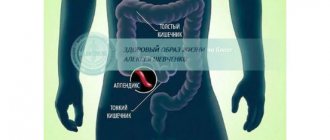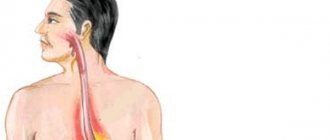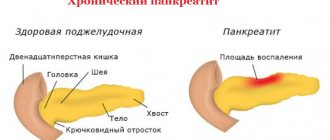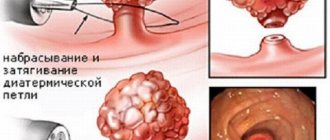Main symptoms
- The first thing that might make you think about appendicitis is pain in the abdomen. Most often, if this is inflammation of the appendix, the pain is localized mainly on the right side or in the navel area. Over time, the pain may move from the center of the abdomen to the right and down, but not reach the border of the pelvic bones. Remember that in pregnant women, appendicitis may change its location depending on the stage of pregnancy, so the pain may be slightly higher.
- Try to lie flat on a hard surface and lightly press on your stomach in the area where the pain is located. If, even with fairly light pressure, you experience acute pain in your right side, call an ambulance immediately.
- Usually, when you press on the stomach, you should feel that it is soft, your fingers lightly press the tissue and sink into it. One of the symptoms of appendicitis will be a hard belly, even hard to some extent. In addition, note whether bloating is present. Seek medical help immediately.
- Try to stand up and walk around straight. At the first signs of inflammation of appendicitis, it is impossible to do this without feeling severe pain. And if you try to “curl up” with your legs tucked to your chest, the pain may become significantly less.
Signs of appendicitis in women
Determining appendicitis in women is much more difficult than in men. The fact is that some diseases and pathologies in the female body have similar symptoms. For example, among them are ectopic pregnancy, disorders and pathological changes in the appendages, the presence of apoplexy in the ovary, and uterine diseases. Unlike men, the female body is designed in such a way that the organs of the genitourinary system border in close proximity to the gastrointestinal tract.
Characteristic signs of appendicitis in women:
- intense pain in the stomach;
- nausea;
- severe vomiting, after which the woman does not feel relief or improvement in well-being;
- high temperature, within 39° and above (an increase in temperature does not always occur);
- a feeling of dry mouth (this symptom signals rupture of appendicitis and the onset of the inflammatory process);
- diarrhea (not always manifested, but accompanies many patients).
To exclude female diseases and make a diagnosis of appendicitis, a woman is strongly recommended to undergo additional examinations at a medical institution.
Main features
You should also pay attention to the other signs of appendicitis; it is not at all necessary that they will all appear at the same time; just a few are enough to know for sure that the time has come to ask for help from doctors:
- You should not delay visiting your doctor if you have a very high temperature (38° - 39°). If it is significantly higher, call an ambulance;
- Chills and heavy sweating indicate the presence of inflammation in the body;
- Constipation, especially if vomiting is added to it, clearly makes you understand that the appendix is inflamed;
- Diarrhea, especially if it contains blood particles, indicates the same thing;
- Nausea or vomiting;
- Back pain similar to renal colic;
- False urge to defecate.
What you definitely shouldn’t do if the question is about possible inflammation of the appendix:
- If, in addition to abdominal pain, you have a high temperature, you should not wait, it is better to call a doctor or an ambulance.
- Under no circumstances take any painkillers or laxatives, this will only worsen the situation when diagnosed by specialists.
- Do not take any medications for the stomach or intestines, they can only cause a strong chemical reaction that will cause the appendix to rupture.
- Try to avoid eating until medical attention is provided; you may need surgery. This should also be done in order not to cause irritation of the intestinal mucosa, which can significantly increase the pain.
Useful: First signs and symptoms of appendicitis
When is it necessary to call an ambulance?
If you observe several signs of appendicitis, especially if they are accompanied by vomiting and severe pain, call an ambulance immediately!
After doctors visit you, it is very important to accurately describe all your symptoms and signs. Do not ignore any violation that has occurred over the past 2-3 days (it does not matter whether it is vomiting or diarrhea). Be sure to notify your doctor about the first pain sensations that you could not ignore.
Keep in mind that for a reliable diagnosis, the doctor needs to examine you completely, including palpating your abdomen, in order to exclude peritonitis from the list of possible diagnoses. If necessary, your doctor may do a rectal examination to confirm or rule out appendicitis. With peritonitis, the abdominal muscles will be very tense.
In case of an implicit or vague diagnosis, additional examinations are often prescribed: urine and blood tests, ultrasound of the pelvic organs, a probe (an instrument in the form of a thin rod intended for carrying out diagnostic or therapeutic procedures in various cavities and canals of the human body), etc.
Some good advice
The most dangerous complication of appendicitis is its rupture. During tissue dissection, all its contents end up in the abdominal cavity, which is sterile, and infection penetrates there. This may cause the development of peritonitis.
It should be remembered that in children the first signs of appendicitis may manifest differently due to the immaturity of some body systems. In addition, not all children can clearly and distinctly explain where, how and what hurts them. Most often, the child endures pain, believing that it is just an intestinal ache, and may refuse to eat and really want to sleep. Therefore, if your baby refuses his favorite dish, you should be wary and find out the reason for what is bothering him. Not all people exhibit the symptoms and signs described above.
Classic symptoms do not occur in people who fall into the following categories:
- diabetics;
- pregnant women in the 3rd trimester;
- obese people;
- cancer patients;
- HIV-infected;
- people who have had organ transplants;
- elderly age;
- Small children.
Diseases with similar symptoms
It is not always possible to recognize appendicitis at the first examination without additional tests and examinations. This happens only because the primary symptoms of the appendix are very similar to the signs of other diseases that painfully “give” to the same area.
So, here is a small list of such diseases:
- inflammation of the ovaries, fallopian tubes or uterus;
- pyelonephritis;
- renal colic;
- Crohn's disease (also called terminal ileitis);
- ulcer and its perforation;
- enterocolitis and colitis of varying degrees;
- inflammation of small intestinal nodes;
- inflammation of the testicle;
- rupture, sometimes stretching, of the anterior abdominal muscles and more.
Ultrasound of the pelvic and abdominal organs does not always help to make an accurate diagnosis. This happens due to the fact that something can be viewed on an ultrasound machine or simply not seen due to the imperfection of the technology or the skills of the specialist. Only laparoscopy can give a 100% result in making a diagnosis.
Causes of the disease
Appendicitis can occur at absolutely any age. But more often young women encounter it. The causes of the disease are as follows:
- disturbance of the blood flow of the appendix or its displacement;
- inflammatory process in nearby organs;
- intestinal infection;
- excess serotonin;
- blockage of the organ with small objects (seeds, bones, etc.);
- clogging of the lumen with feces.
In women, appendicitis often occurs due to gynecological diseases. One of the most common causes of the disease is considered to be an inflammatory process in the pelvic organs. Diet, lifestyle and stress have no less influence on the condition of the appendix. The development of the disease occurs in stages:
- The initial stage of inflammation is called catarrhal.
- The next stage is characterized by the formation of purulent ulcers.
- The phlegmonous stage is characterized by an increase in the appendix and its filling with pus.
- At the last stage, the appendix ruptures.
Causes of inflammation of the appendix
Despite the rapid development of medicine in all its fields, it has not yet been possible to fully study all the causes of inflammation of the appendix. Appendicitis is an inflammatory disease that often goes unnoticed and appears suddenly. It is impossible to predict its manifestation.
Inflammation caused by various microorganisms (anaerobes, staphylococci, E. coli, streptococci, etc.) occurs in the vermiform appendix of the cecum.
Often the result of inflammation of the appendix is an excessive overload of the body with protein foods: frequent overeating and obesity due to overeating. Modern people spend a lot of time sitting at work, and then at home near the computer; such a sedentary lifestyle can also provoke inflammation of appendicitis.
What types of appendicitis are there?
In addition to the popular, “acute” form, which requires urgent intervention, there is the so-called chronic appendicitis. This is a rare pathology characterized by the formation of damage on the walls of the process, which every now and then blocks the entrance. This complicates the outflow of mucus, but, at the same time, is not critical. You can live with chronic appendicitis by carefully monitoring the course of the disease. However, doctors still advise removing the rudiment in order to put an end to this problem once and for all. This form of the disease is at great risk of developing into an “acute” form at any time.
Stages of inflammation of the appendix
Classification of acute appendicitis:
- catarrhal (simple, superficial);
- phlegmonous;
- empyema of the appendix;
- gangrenous
A separate type includes diseases that are a complicated form of appendicitis, such as appendiceal abscess, perforation, peritonitis, pylephlebitis, retroperitoneal phlegmon, sepsis, etc.
How to avoid appendicitis?
In order to minimize the risk of inflammation of appendicitis, it is very important to maintain proper nutrition. At the same time, try to use only easily digestible proteins in your diet. They are found mainly in a variety of dairy products.
You should also eat fresh fruits and vegetables every day. The most useful ones will be those grown in your own garden or bought from summer residents. Try not to overeat and always watch your calorie intake.
Periodically do fasting days and monitor the health of the gastrointestinal tract, and prevent constipation.
Related article: diet after appendicitis
Rupture of appendicitis is a risk of death, so do not try to cure it yourself, but get tested by your doctor or call an ambulance.
- Remember, a subsidence of pain or, conversely, an excessively sharp increase in pain may indicate the onset of serious complications.
- It is very important to know the first signs and symptoms of appendicitis in order to seek help from specialists in time.
- At the slightest suspicion of appendicitis, especially in young children, immediately call an ambulance; it is better to make sure once again that it is not inflammation of the appendix.
Appendicitis during pregnancy
About 2% of women experience appendicitis during pregnancy. The state of expecting a child is always a great stress for the body and a time of exacerbation of many chronic diseases. It is during pregnancy that there is the greatest likelihood of exacerbation of chronic appendicitis. Inflammation of the appendix at this time poses a great danger to the woman’s body and to the life of the unborn child. Appendicitis, accompanied by complications, can cause fetal death.
YOU WOULD BE INTERESTED
Appendicitis in men
Pregnancy is characterized by various symptoms. Inflammation of the appendix is disguised as toxicosis, so most women during pregnancy do not pay attention to the general malaise of the body. Moreover, such a malaise may be due to appendicitis. In this case, it is recommended to contact a specialist to establish the correct diagnosis and provide assistance.
Appendicitis in pregnant women can only be treated surgically. This method is completely safe for the fetus and the woman herself.
Some interesting cases from medical practice
1 case from medical practice
A young 28-year-old guy came to see a doctor with pain in his right side. When asked how long ago the pain began, the answer was about 8 hours ago. His side began to hurt completely unexpectedly, for no apparent reason, and his temperature rose slightly to 37.8°.
During the examination, the doctor determined that the pain was spreading from the left side to the area just below the navel. At first glance, the symptoms indicated peritonitis.
The patient was diagnosed with acute appendicitis. The young man was immediately taken to the surgical department to the operating room for a laparotomy. During the operation, it turns out that the process of the cecum is not at all changed despite the presence of serous effusion in the peritoneum. It was decided to examine the small and large intestine more carefully. As a result, an inflamed diverticulum (embryonic bile duct) was found at their junction. It was removed because... It was he who caused symptoms similar to appendicitis. Most often, inflammation of the diverticulum occurs without any symptoms, and in only 5% of people it is detected during laparoscopy or some other operation.
2 case from medical practice
A 65-year-old man with suspected acute appendicitis was taken by ambulance to the hospital emergency room. The necessary tests were taken and additional examinations were carried out. It was decided to operate because other methods could not eliminate the pain. The patient agreed to undergo the operation.
During the operation, the surgeon discovered an inflamed appendix with a dense consistency. Its length was 3.5-4 cm, there was a fibrin coating and obvious signs of the inflammatory process. The appendix was removed. After the operation, the wounds began to fester a little, despite this the patient was discharged home.
After 21 days, a conclusion was received after an examination of the appendage. Result: appendicitis cancer. The necessary data was transferred to the clinic at the patient’s place of observation. He was called to an appointment for consultation with an oncologist. The man chose to refuse further treatment. He died 6 months later.
Postoperative period
After the operation, the doctor prescribes antibiotic therapy. Medicines and their regimen are selected on an individual basis. If there is a predisposition to thromboembolism, anticoagulants are prescribed.
A scar measuring up to 10 cm is formed at the site of the operation. It heals for about six months. Immediately after the operation, it has a burgundy tint, and over time it turns white. To resolve it, specialized ointments and creams are prescribed. Following your doctor's recommendations ensures a quick recovery. With proper care, the likelihood of wound suppuration is significantly reduced.
Diagnosis is simplified by specific symptoms of appendicitis in women; how to determine the disease at home becomes clear after studying physiology. The main difference is the location and nature of the pain. But only a specialist can make a final diagnosis.
- Features of surgical intervention for various forms of acute appendicitis
- Recovery period after appendicitis removal. Rehabilitation during the postoperative period of appendicitis, what can and cannot be done
- Purulent appendicitis with peritonitis
- Symptoms of appendicitis in children from 1 year to 15 years










